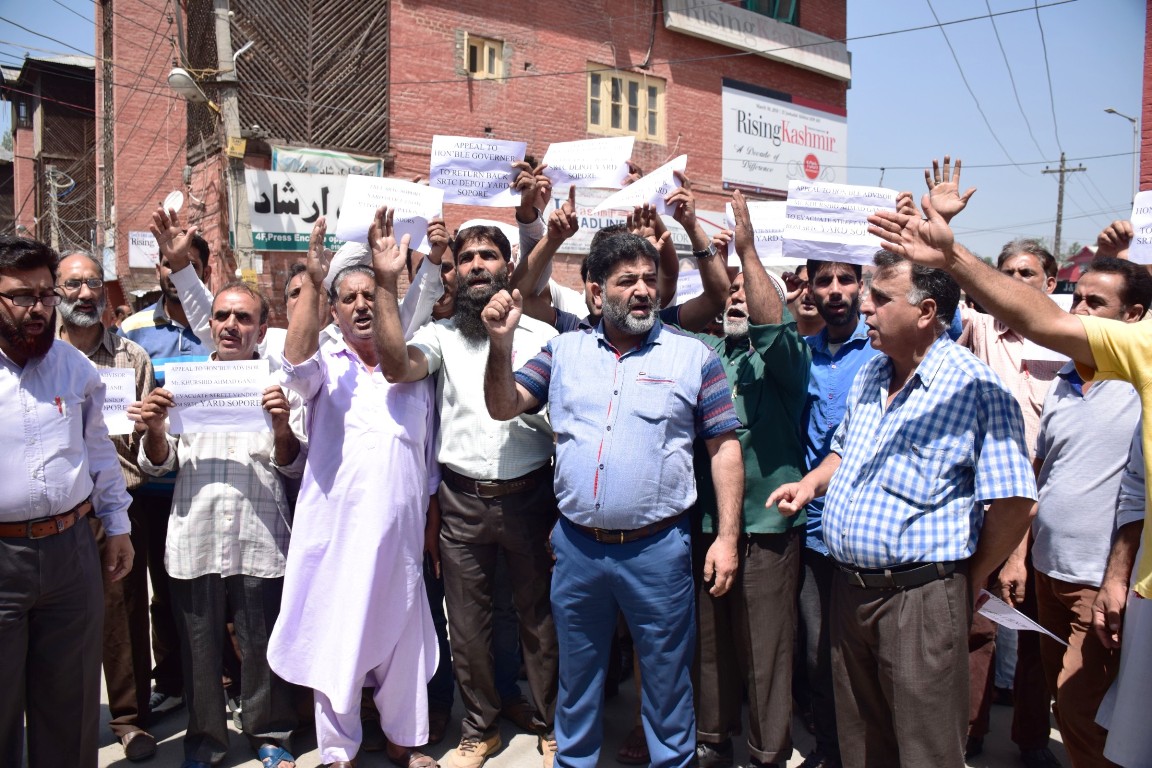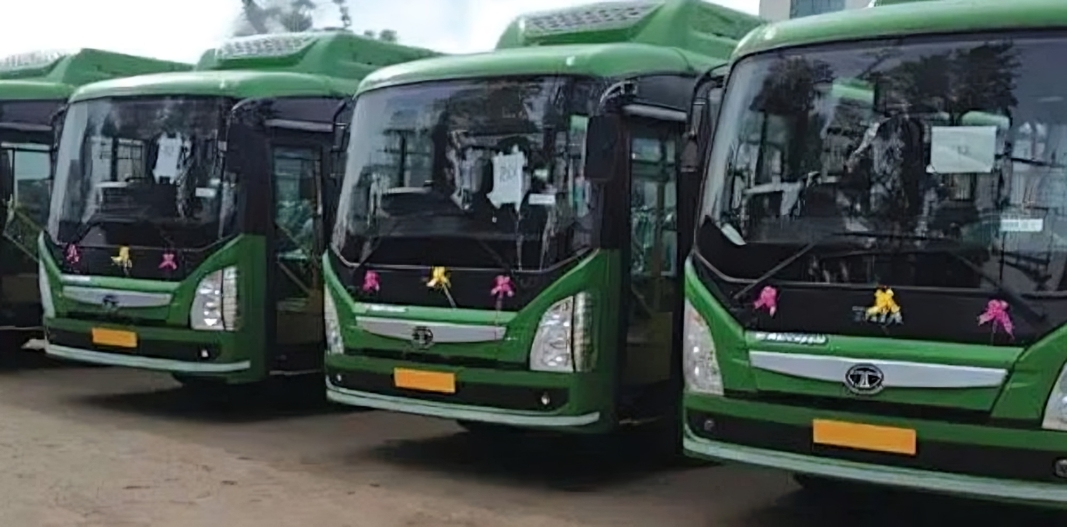Barely a couple of years after Jammu and Kashmir’s public transporter, the JKSRTC received a brand new fleet of vehicles and buses, and the turnaround began. For fiscal 2023-24, the corporate anticipates Rs 200 crore turnover, a quantity that was as soon as a utopian determine, studies Babra Wani
In 2019, the Jammu and Kashmir Highway Transport Company (JKSRTC) unveiled a fleet of digital buses, referred now because the “inexperienced buses”, in Kashmir. Then, the potential affect of those buses was not broadly recognised. In 2023, this fleet has grow to be a supply of constructive change for each commuters and the company.
These buses have emerged widespread technique of transport. “Since these buses began working, a lot of our points have been addressed,” a Chadoora resident, who now travels by RTC bus stated. “The fare is economical, the buses are snug, and there’s no want to attend for them to achieve full capability. They adhere to particular schedules.”
These buses have garnered commendation, notably for his or her designated part for feminine passengers, enhancing comfort for commuters.
Out of about 40 buses for Jammu and Kashmir, twenty are operational in Srinagar. At present, eighteen e-buses are in operation, whereas two are present process upkeep, as confirmed by a senior JKRTC officer.
Whereas the commuters are glad, the company can be content material with what it’s doing – after a really very long time. “The company had been grappling with excellent debt, presenting a big problem,” an officer stated. “Nevertheless, there’s now a noticeable enchancment within the scenario, with a reversal of the losses incurred.” The company hopes it would report a turnover of Rs 200 crore for fiscal 2023-24.
The Starting
A senior firm govt knowledgeable that the Ministry of Heavy Industries and Public Enterprises, a Authorities of India entity, launched the Sooner Adoption and Manufacturing of Hybrid and Electrical Automobiles (FAME) scheme to handle city air pollution attributable to autos.
“The Authorities of India bore 60 per cent of the associated fee, below the scheme, with the remaining 40 per cent falling on the state authorities. In step with this, JKSRTC issued a young in 2018 for the manufacturing of those buses by TATA Motors. The buses had been commissioned and put into operation on the roads of Jammu and Srinagar in June 2019.”
This fleet is a part of a Central Authorities initiative to mitigate air pollution. “These buses are distinctive, representing a brand new enterprise even for TATA Motors, because the idea of digital buses was unprecedented earlier than their introduction,” he stated. Earlier than they had been launched in Jammu and Kashmir, the e-buses had been already enjoying efficiently in different states.
The Company administration is taking additional care in guaranteeing these buses are usually not broken. They’ve arrange an in-house upkeep system. “We handle the upkeep of those buses ourselves,” the officer stated. “Because of the excessive price of spare components, some exceeding a lakh of rupee, and the importation of sure parts from overseas international locations, these buses incur vital upkeep bills. Nevertheless, the buses presently present process upkeep will quickly be again on the highway.” On the flip aspect, nevertheless, these buses have “a finite shelf-life”.

In contrast to non-public transport, the officer stated the social commitments of the general public transporter stop it from changing into a profit-maker. “It’s primarily a service. Whereas our present earnings are passable when contemplating the general prices concerned—reminiscent of driver and conductor salaries, and bus upkeep—we discover ourselves unable to interrupt even,” the officer stated. “When you look at the bus fare, it’s comparatively low. Moreover, the gap coated is proscribed, resulting in extra losses. Moreover, seats are reserved for college students who pay solely half of the common fares, regardless of their pupil standing.”
The Fleet
The JKSRTC is without doubt one of the oldest public transporters within the area. In 1947, vehicles and buses owned by firms reminiscent of ND Radhakrishnan, Allied Chirag Din & Sons, and Nanda Bus Service confronted issues in a modified geo-political scenario forcing the Jammu and Kashmir authorities to arrange its transport utility. It formally began operations as Authorities Transport Enterprise (GTU) on January 5, 1948, with 50 vehicles procured from M/S Common Motor Company, Bombay. The GTU, based on January 5, 1948, remodeled into a company on September 1, 1976.
All through its historical past, the JKSRTC has remained a part of the politics, folklore and communication of Jammu and Kashmir. It’s the one that will drive individuals out of Kashmir. It has been a part of all wars and skirmishes within the area. In militancy, it misplaced almost 120 buses and vehicles just because a militant outfit was opposing the telecast of the Doordarshan tele-serial Bible Ki Kahaniyan. Then it reached a stage the place it lacked sources to feed its employees forcing the federal government to offer it a lease of life – budgetary help – Rs 30 crore a yr. It gave up routes and alternatives that progressively the non-public transport took, inch by inch.
“We had been getting Rs 7.5 crore of budgetary help each quarter that will often go into managing the persistent money owed we had,” the officer stated. “Final yr we received it every year however, in some way, we managed our necessities. Our salaries are on time and our liabilities have lowered considerably.”
Proper now, the JKSRTC has an general fleet of 110 autos together with vehicles. It consists of solely 40 e-buses, relaxation are diesel-fuelled. The general bus fleet is barely greater than 200. “In Kashmir, we’ve 130 buses operational on district routes, 55 function on nationwide freeway; in Jammu, there are 60 buses managing the inter-state community, 45 are devoted to district routes,” the officer stated. “Srinagar metropolis has 20 buses and Jammu metropolis has 16 operational buses proper now.”
The Mandate
Public transporters have commitments as they don’t function for mere revenue. It supplies inexpensive and punctual transportation providers to commuters and adheres to strict schedules.
“Losses are inherent in numerous fleets, however we preserve diversified fleets,” the officer stated. “In situations the place losses happen in a single sector, we attempt to offset them by producing earnings from different sectors.”
“Final yr, we had a income of Rs 150 crore and this yr, we’ve surpassed Rs 183 crore and we hope we’ll get Rs 200 crore turnover by March 2024,” the officer stated. “However it’s also vital to notice that our income comes higher from our vehicles and never buses. All public transport buses throughout India are usually not a worthwhile operation.”
The company’s load division is important for the state’s public distribution system, particularly in distant areas like Gurez, Tangdar, Machil, Keran, Leh, Kargil, Nobra, Zanskar, and so on. In addition to, the company supplies carriage to varied authorities departments and companies, together with the Division of Client Affairs and Public Distribution, the Meals Company of India, the Military, the BSF, Beacon, SICOP and others.
“So long as the wheels are in movement, there are higher earnings,” he stated. “Our providers catering to longer routes, exceeding 200 kilometres, are extra worthwhile in comparison with metropolis routes, the place distances are shorter, and visitors congestion limits profitability.” Company’s income would have been higher had they not a task in metropolis transport programs.
An Evolving Sector
Public transport is a fast-evolving sector, the world over. Earlier, all of the buses in India had been truck platforms (bear in mind the KMDA buses). It took years to introduce buses which are supposed to be buses. With newer applied sciences, buses have grow to be spectacular items of consolation.
“Beforehand, it was gas and now it’s gas cell, a shift from diesel tanks to batteries. The buses are fully digital,” the officer stated. “About two years in the past, throughout extreme winter situations with temperatures dropping beneath freezing, a automobile that often takes two to a few hours to cost took greater than 4 hours. We filed a grievance, and TATA despatched a crew to improve their software program primarily based on our suggestions.” Nonetheless, weather conditions are an enormous problem to those applied sciences.
The consolation comes at a value. An e-bus prices round Rs 1.25 crore, whereas a diesel-run bus is prepared at nearly Rs 30 lakh, a five-time funding. In diesel buses, there are 50 seats and e-buses have solely 32.
Working the trendy fleet requires creating new infrastructure. Inspected by the government-run CIRT, these buses have strategically positioned charging stations in Bemina and Lal Chowk. After protecting 120 km, buses require recharge. Upkeep is dealt with on the unique workshop in Bemina managed by JKSRTC.
“Whereas it’s 5 instances costly, we’ve to take care of a budget fares,” he requested. “We’ve got proposed to public sale nearly 237 buses this yr and we’ve additionally initiated the method to obtain extra autos.” Nonetheless, we ferry almost 40 lakh passengers a yr. Nevertheless, the company saved a bit by hiring conductors and drivers on a contractual foundation.
The Revival
High company executives credit score their Managing Director, Rakesh Kumar Srangal for the turnaround. With over two years of tenure, Srangal launched an easy roadmap that proved instrumental in reworking the monetary standing of JKSRTC.
“Because of his policy-making and laborious work, we’ve seen vital enchancment,” an govt stated. “Our terminal liabilities have lowered, and we’re projected to earn Rs 200 crore this yr. All staff are diligently contributing to the sleek functioning of the company.”
#JKSRTC #Managed #Coming #Purple



